Crossref Registrar. DOI database search
- February 27, 2023
- Posted by: Yury Subachev, PhD
- Category: For young scientists
-
Post Views: 744
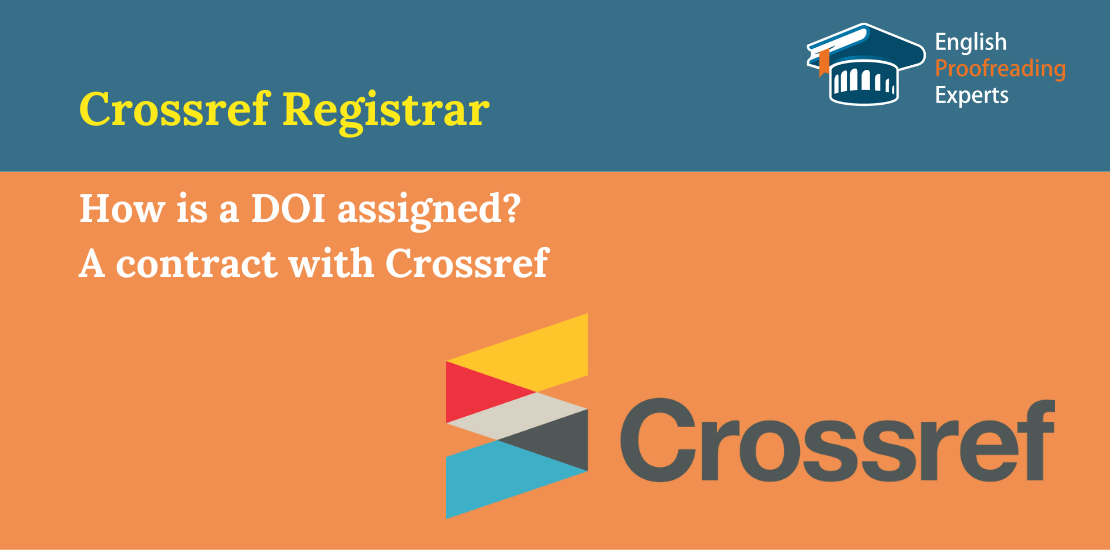
Crossref is an official registrar of DOI (Digital Object Identifier), i.e. the organisation in charge of assigning an identifier to materials published on the Internet. The agency was set up for scientists and publishers to facilitate and accelerate their research activity through simplified search of scientific papers online.
Crossref encompasses various publishers, higher educational institutions and scientific organisations. The system maintains reciprocity of scholars and publishers, promotes increased citation rate, helps to find information about published materials; however, it does not provide access to full texts of research papers.
The article will acquaint you with the specifics of concluding a contract with Crossref, the rules for assigning and search of the DOI.
Crossref is nominally a non-profit organisation set up with the purpose to help scientists in finding and citing scientific publications posted on the Internet. The agency was founded in 2000 by a group of publishers willing to create permanent access of in-publisher links in online journals. The organisation is registered in the USA, New York, formally known as Publishers International Linking Association (PILA), with the official website.
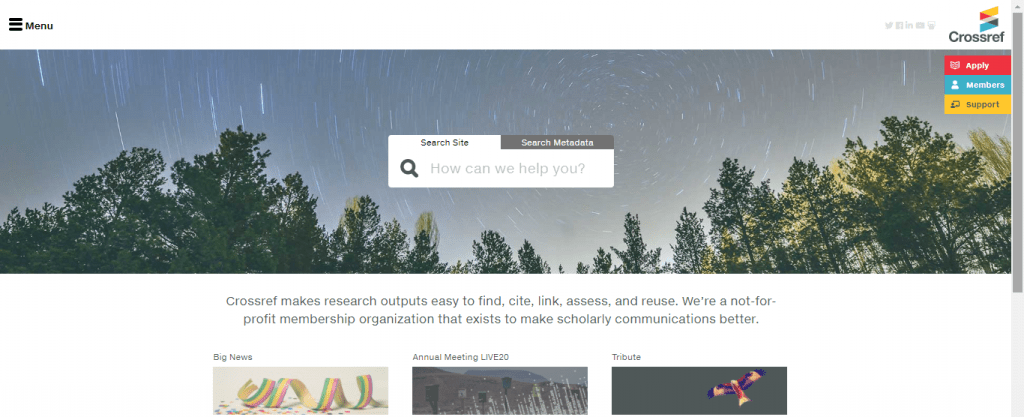
In 2012, the platform received an award from the Association of Learned and Professional Society Publishers (ALPSP) for its significant contribution to the development of scholarly publishing.
Today, the community team comprises several dozen people. It is managed by the Board of Directors which controls the activity of the organisation, sets the direction of its development and monitors compliance with its goals. The Board of Directors is selected by all community members at annual online election. The structure and functional titles of the Crossref team can be found on their website under “Organisation chart” section or by going to https://www.crossref.org/people/org-chart/.
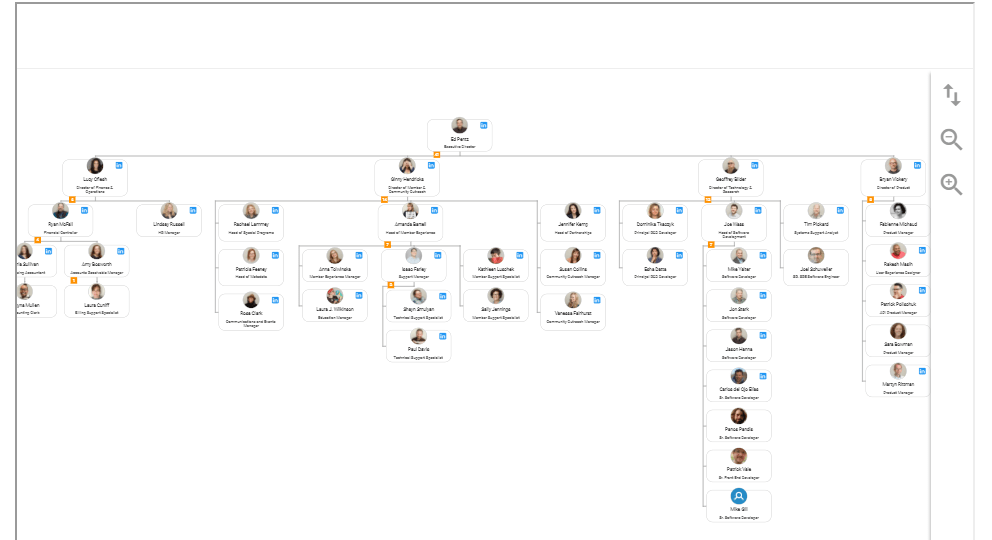
The Crossref community includes about 2,000 publishers with voting rights representing more than 4,000 groups as well as representatives of higher educational institutions, libraries, private publishers, for-profit and non-profit organisations, search engines. The platform is used by major global publishers such as Elsevier, IOP Publishing, and John Wiley & Sons as well as the international scientometric databases Scopus and Web of Science. The community members assign a DOI code to journals in Crossref and give links to other members’ materials as based on their own publications. Reciprocity is the core of the Crossref’s work.
The portal encompasses over 80 million items of diverse material in technical, social, medical and many other disciplines, including journals, books, monographs, reports, technical documentation, conference papers and more. The Crossref content marked with DOI is growing on a daily basis.
Specific features of the database:
- it links scientific references, thus greatly facilitating interaction between information sources published on the web;
- facilitates and accelerates academic activity through advanced technologies;
- contributes to the development of electronic infrastructure;
- maintains the worldwide reciprocal citation structure;
- allows to conclude collaboration contracts by the participants;
- does not provide access to full texts of research papers;
- stores information on affinity of publications and metadata of published works;
- assigns the DOI to papers;
- checks texts for plagiarism.
Crossref is an open rapidly developing platform inviting all its participants to active interaction. There one can always find information of interest on the agency’s activities and the history of its development. The community encourages everyone to adhere to the following principles:
- “Join in, all or individually”. It is a global association seeking to enhance the scientists’ interaction and cooperation in research and to ensure due preservation of academic data. The portal members represent different disciplines in a variety of formats, using diversified business models.
- “Smart – one by one, outstanding – all together”. Crossref actively advocates cooperation, as well as formation of committees and work groups. The team is convinced that joint work contributes to achievement of any goals.
- Every member of the community has a say regardless of their rank or position. This is important for the formation of a collective body involved in setting agenda and taking important decisions.
- Love for metadata and technologies. The agency fully supports and develops the common infrastructure intended for the use by the scientific community through a set of research and development activities. To achieve accessible content and free exchange of information between the participants, new tools and API services are being created on a permanent basis.
- Getting everything that you can see. The organisation advocates openness and transparency of knowledge and published materials.
- Crossref intends to secure its positions for an indefinite term, while constantly improving and evolving, concerned about meeting its users’ demands.
Since most publishers use the Open Journal Systems platform for their journals’ web portals, the Crossref team regularly develops modules for integration of database services into OJS. These are due instruments intended to export metadata and activate DOI identifiers quickly and easily.
Crossref was rebranded in 2015, with changes to the community name (formerly CrossRef, meaning cross-reference) and the range of provided services (their list and number of groups were extended); however, the main changes concerned the agency’s logo.
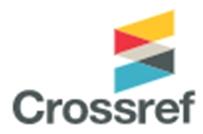
The updated logo symbolises the characters ‘<’ and ‘>’ designating brackets used in information technologies. At the same time, these are arrows showing the direction of metadata movement in import and export. As to the colours, they represent the key areas of Crossref’s activities:
- yellow (Play) – discussing and testing technologies developed for solution of problems;
- red (Rally) – consolidation of the academic community;
- grey (Run) – running and managing the infrastructure to handle the content;
- grey (Make) – creating tools for improvement of research communications;
- blue (Tag) – processing and structuring of metadata.
2. How is a DOI assigned? A contract with Crossref.
The acronym DOI stands for a digital object identifier, that is, a unique code assigned to any content posted on the Internet; it provides brief information on the published material. The code is assigned to intellectual property objects, namely, articles, dissertations, books, documents, datasets, tables, figures, etc. The DOI identifier is registered by Crossref as a Unified international register and does not change throughout its existence.
What for is this identifier needed?
- This standard is used by the world’s leading publishers and the Publications Office of the European Union.
- It is accessed by scientists from all over the world to share information.
- The DOI shows a path to the file published on the Internet.
- The code can be used to make search through the DataCite.
- The ID is used for commercial video content.
- When DOI-coded articles are cited the work and its author are entered in the database.
- Finding, citing and localising research papers is much easier with a code.
- If an article is assigned a standard it is almost impossible to lose a reference to it.
- The identifier protects intellectual property.
To be able to register for a DOI in Crossref independently, it is necessary to sign a contract with the agency, draw up an application, send one copy of the contract and the application form with official stamps to the community. The response and the contract signed by the company reaches the applicant on expiry of six months.
How to conclude a contract:
1. Go to the official website https://www.crossref.org/ and open the “FOR PUBLISHERS” tab, select “request membership” to join:

2. Fill in the information about yourself and your place of employment in the form that opens and click “Submit”.

3. You will receive an e-mail reply.
4. Fill in the attached contract and application form, affix signatures and rubber stamps. Confirm your return address with the agency staff – for your further receipt of two contract copies and the application form.
5. Receive a reply from the company on your membership, with a signed contract, after a lapse of 6 months.
To become a member of the community, you need to pay a membership fee; the payment information comes to your mail as well. After the payment, a participant receives a letter with confirmation, congratulations and thanks, containing as well a link to register the DOI on Crossref, login and password and a personal prefix with the publisher.
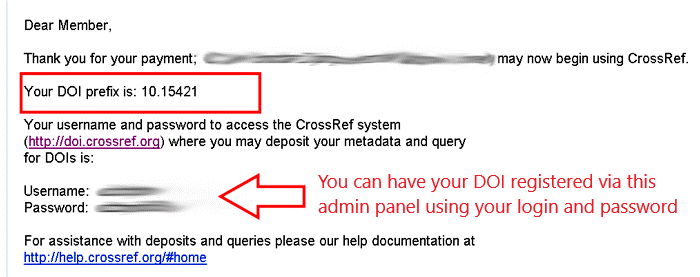
The membership fee is charged annually in January; in addition, registration of metadata requires payment as well. The fee will depend on specifics of the content to be posted. The fee is formalised as arrears to be paid by the end of a current quarter.
After the registration, a participant can upload own materials and assign a DOI to them. To upload the data, just go to https://www.crossref.org/webDeposit/ :
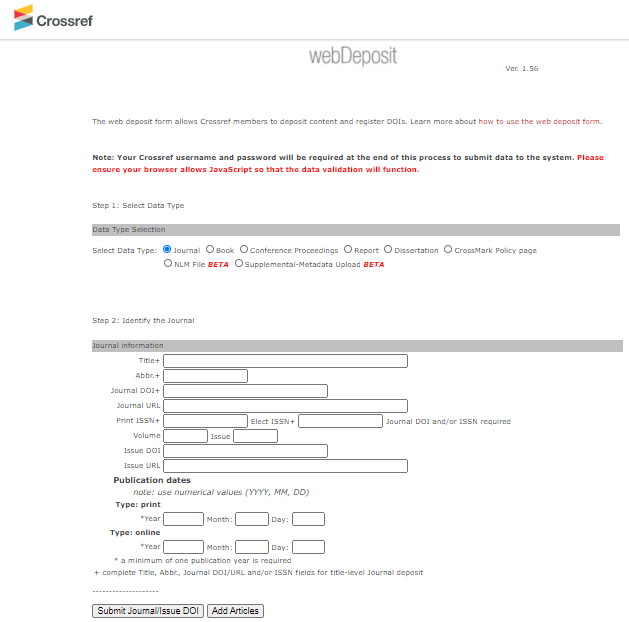
How to fill in the form correctly:
- Select the type of content to be uploaded (article, book, etc.).
- Fill in the information about the journal as accurately and completely as possible (full and abridged name, journal ID and reference to it, year, issue number and other information).
- Fill in the information about the article by clicking the “Add Articles” button (original and English title, authors’ details and organisation where they work). If you are adding metadata, select “Add Cross MetaData”.
- Enter the e-mail address to which the upload result will be sent.
To see the status of the check, it is necessary to log in to your personal account using your login and password. If everything is correct click “Deposit” to start data processing. This may take several hours to several days. In order to check the uploaded data later on, you need, after logging in, to go to the home page and select “Submission administration”. The result is automatically displayed.
The DOI is assigned to both the entire scientific work and its individual fragments. Reputable international publishers do this automatically.
3. How do I find a DOI?
It may be necessary to know the DOI identifier, when submitting an article to a foreign journal. In this case, it is necessary to specify a unique code for every literary source. In order to search for relevant information, it is not necessary to register on Crossref. It is sufficient to use a special search form which can be found at https://doi.crossref.org/simpleTextQuery.
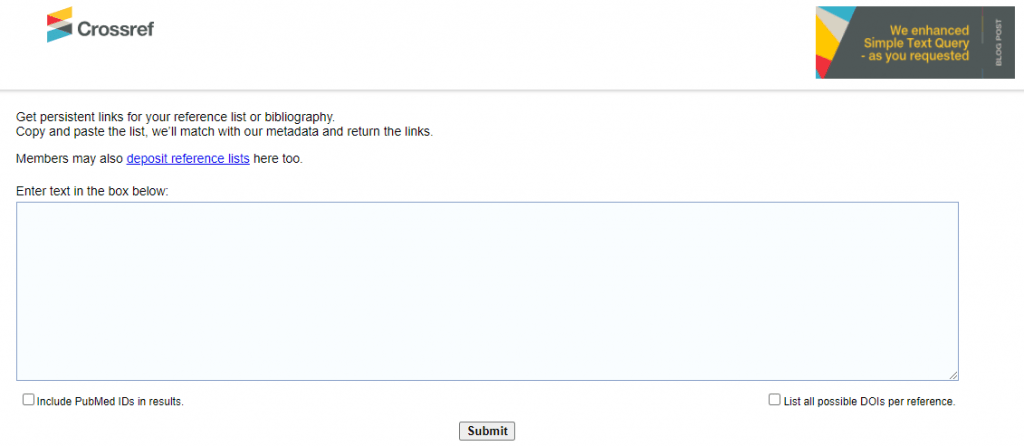
A link to the material of interest should be inserted into a special box; after the action is confirmed, Crossref will display the DOI. In addition, the article DOI can be found directly in the article – where all information about the publication is placed. It is convenient to use the elibrary.ru for this purpose.
Similarly, the DOI can be used to find the information about the content to which it has been assigned.
Conclusion
Assigning a DOI via Crossref is an opportunity to preserve a reference to your published material without the risk of losing it; it involves as well a quick and convenient search of various information sources posted on the internet. In order to assign a unique identifier to your content, just sign a contract with the association and pay the annual membership fee. In order to search for information by DOI, membership is not necessary – just enter a reference into a special form and get the sought data.
Crossref is a large organisation that brings together academics and publishers from around the world. The agency actively supports cutting-edge technologies and interaction between the community members. Its members include some of the world’s largest publishing houses and scientometric databases. The company is continually improving and developing, and its database is daily updated with new materials from various fields of knowledge.
How useful was this post?
Click on a star to rate it!
Average rating 5 / 5. Vote count: 3
No votes so far! Be the first to rate this post.
